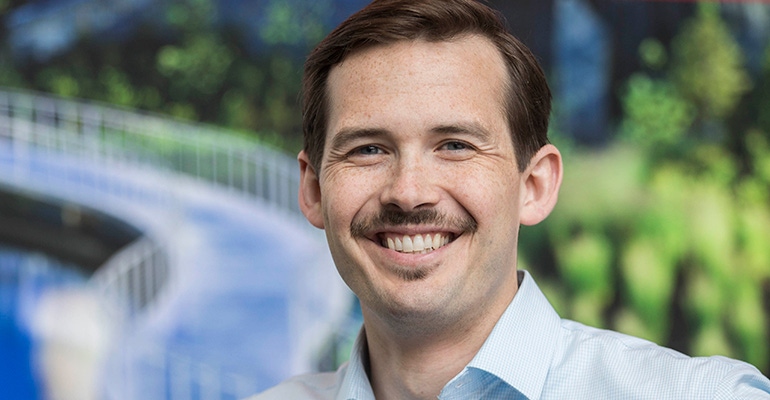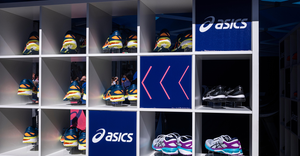We recently spoke with the Waste360 40 Under 40 award recipient about his role as solid waste engineer and how to avoid leachate in landfills.

Mike Classen, solid waste engineer at HDR, discovered his passion for landfill design and landfill operations during an internship in college, when he stumbled upon an opportunity in the waste and recycling industry.
Since entering the industry approximately 10 years ago, Classen has implemented efficient compliance monitoring concepts for clients that have saved their agencies thousands of dollars, created efficient and effective landfill designs and solutions and has come up with creative ways to tackle the issue of leachate in landfills.
In addition to working at HDR, Classen is a Solid Waste Association of North America (SWANA) Young Professional, a member of the Board of Directors of the Iowa Society of Solid Waste Operators and head of the Technical Advisory Committee (TAC).
“What I love about being an engineer is talking about a problem a client is having and coming up with an idea to help them solve it,” says Classen. “At the end of the day, I enjoy seeing my designs get constructed, and finding out that my design ideas have helped our clients improve their operations and overcome their challenges.”
We recently spoke with the Waste360 40 Under 40 award recipient about his role as solid waste engineer, how to avoid leachate in landfills and how he has helped implement more efficient compliance monitoring concepts for clients to help them save money.
Waste360: How did you land your first position in the waste and recycling industry?
Mike Classen: When I was in college, I was studying meteorology, but after rethinking some things I made the switch to biological systems engineering. Once I made the switch, I landed an internship in the waste and recycling industry and that’s really where it all started for me. From there, I worked for at that same company for about seven years, and then I made the switch over to HDR about three years ago.
When I first entered the field, I didn’t really have a good understanding of solid waste management, but I quickly fell in love with landfill operations and landfill design, and that’s the path I decided to take.
Waste360: Tell us about your role as solid waste engineer and some of your daily duties.
Mike Classen: I work in a client service business so the number one thing that I focus most of my time on and take the most seriously is making sure that I am doing everything possible to make my clients’ lives easier, from helping them operate their systems to taking loads off their shoulders to freeing up their time so they can focus on the priority projects that they are passionate about.
In addition to client management, I am highly involved in project management and engineering, which includes tasks like strategic planning, working with clients to identify and initiate projects, designing and executing projects, building out project teams, coordinating with clients and subcontractors, etc. I am a firm believer that you need to be where your clients are, and that is onsite. I visit some clients every week and others every month, depending on their needs.
One of the things that I really enjoy about my job is when my clients change my designs because I take pride in not being perfect and no one knows a site like the people who are there every day. I often take those design modifications and implement them elsewhere so that we can have a continuously improving product.
Waste360: You’re also on the Board of Directors of the Iowa Society of Solid Waste Operators and you’re the head of TAC. Tell us a little bit about those roles.
Mike Classen: I’ve been on the Board of Directors of the Iowa Society of Solid Waste Operators for about five years now, and it’s a very active chapter of SWANA. Iowa is primarily public as far as waste management and landfills go, and the board and TAC work to represent the industry statewide for things like comments to Iowa DNR regulations and technical updates on Environmental Protection Agency (EPA) rule changes.
The goal of the board is to provide value back to our membership, and we do that by looking at things from a operational, regulatory, and technical standpoint and relaying information back to the State of Iowa’s solid waste industry.
The Technical Advisory Committee has recently undertaken a few initiatives, including figuring out what to do with landfills that are reaching the end of their 30-year, post-closure care period. We have provided a comprehensive comment letter to Iowa DNR with a proposed method for managing those sites, and we are currently awaiting IDNR’s response and the continuation of that dialogue.
Waste360: Tell us about the new fill method that you helped develop and implement.
Mike Classen: One thing we do a lot that a lot of other companies don’t is put a significant emphasis on planning all aspects of landfill facility development. The “new” fill method we have encouraged our clients to implement is actually Neal Bolton’s pancake fill method, but with a high degree of planning an detail for how that fill operation looks over three-month, annual, and three year planning horizons.
Ultimately, it’s a compound effect at play. You have to know where you are going months down the road in order to be efficient and run a cost-effective operation day-to-day. Landfill operations are most effective when the fill sequence matches up with all of the other infrastructure development sequences (stormwater management, landfill gas, roads, soil borrow, capping, etc.), and that you’re able to track those metrics to continuously improve operations.
Waste360: How have you helped protect groundwater quality with a leachate collection system and improve stormwater management efforts with a stabilization project?
Mike Classen: Landfills are most vulnerable when you have a big open bathtub and no waste to absorb the water. You really need to think about leachate management during cell construction so that you can avoid leachate from being created.
A lot of the ideas that I have implemented are simply borrowed from when we have seen work well, such as putting up rain covers and flaps during construction and making sure the specs are written in a way that the contractor is responsible for preventing stormwater run-on during construction.
We work with a lot of small sites, and they may build a big hole in the ground that may not get up to grade for years down the road, so managing leachate that falls into that empty cell in creative ways and preventing stormwater from ever becoming leachate is the number one thing for us.
We have done a lot of different studies and test programs in some of the larger facilities in Iowa, and we have used methods like a leachate evaporator, land application of leachate, and phytoremediation to prevent having to haul leachate offsite.
Waste360: You’ve also helped implement more efficient compliance monitoring concepts for clients to help them save money. Tell us about that.
Mike Classen: First and foremost, I don’t like the status quo, and I am pro change. It’s easy when you’re doing compliance work to fall into this routine of plug it in, spit it out and submit the report, but every time that we do a routine compliance report we force ourselves to re-evaluate how we have done it before to see if there’s an opportunity for improvement.
I am always looking for opportunities to reduce the number of things that we are sampling for. We have done a comparison for what’s in the landfill leachate and reduction in unnecessary delineation sampling, and we have reduced the number of monitoring points that need sampling across the full spectrum of compliance monitoring points.
We worked with Iowa DNR to refine the interpretation of some language that’s in the Iowa administrative code related to methane migration and what specifically needs to be sampled onsite. Most states have building and perimeter gas probes, but Iowa code states that you need to sample all site structures. For some sites, that means 50 to 60 different locations for monitoring methane, and that’s just not consistent with the EPA’s rule or the intent of the regulations. We work to maintain compliance while simultaneously doing what’s necessary to eliminate unnecessary sampling and monitoring.
Waste360: What advice would you give to someone interested in having a career in the waste and recycling industry?
Mike Classen: At the end of the day, solid waste is a relatively small field, and it’s a people business. I would say come in and do everything you can to work hard and provide value to those you work with. I would honestly give the same advice to anyone pursing any industry. You have to work hard, be great to work with, and provide value to others in order to succeed. You also have to build strong relationships because those contacts will inevitably become a client or employer of yours in the future.
About the Author(s)
You May Also Like




